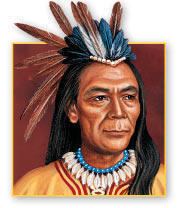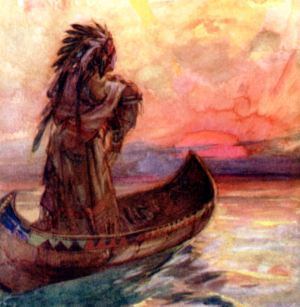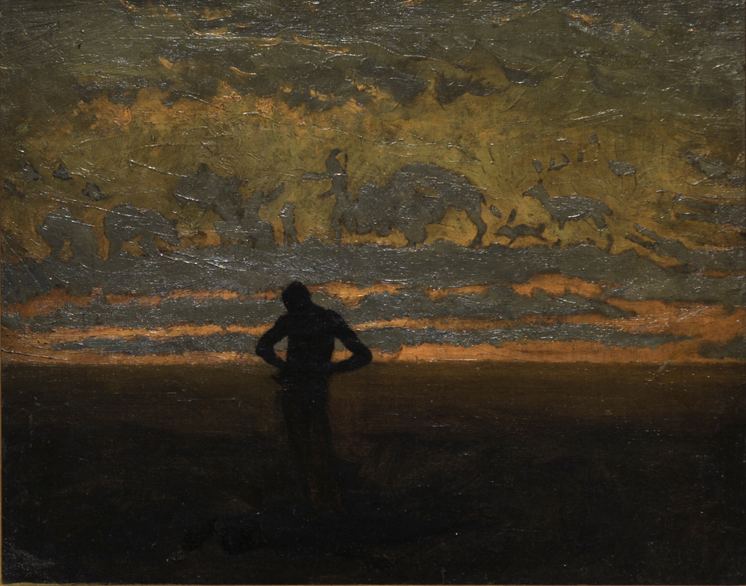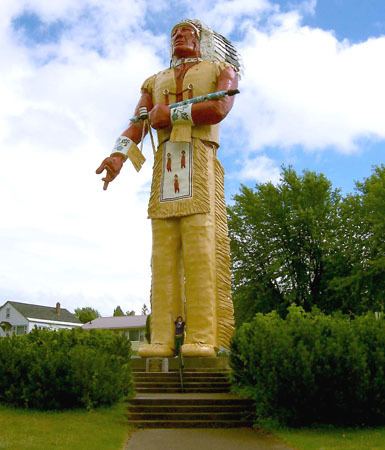Name Hiawatha Hiawatha Died 1595 | ||
 | ||
Similar People Great Peacemaker, Henry Wadsworth Longfellow, Augustus Saint‑Gaudens | ||
Song of Hiawatha
Hiawatha (also known as Ayenwatha, Aiionwatha, or Haiëñ'wa'tha in Onondaga) was a pre-colonial Native American leader and co-founder of the Iroquois Confederacy. Depending on the version of the narrative, he was a leader of the Onondaga, or the Mohawk, or both. According to some versions, he was born an Onondaga, but adopted into the Mohawk.
Contents
- Song of Hiawatha
- Hiawatha s photographing lewis carroll audiobook short peotry
- Eclipse
- Hiawatha Belt
- Posterity
- References

Hiawatha was a follower of the Great Peacemaker (Deganawida), a Huron prophet and spiritual leader who proposed the unification of the Iroquois peoples, who shared common ancestry and similar languages. The Great Peacemaker was a compelling spiritual presence, but was impeded in evangelizing his prophecy by foreign affiliation and a severe speech impediment. Hiawatha, a skilled and charismatic orator, along with a clan mother named Jigonhsasee, was instrumental in persuading the Senecas, Cayugas, Onondagas, Oneidas and Mohawks to accept the Great Peacemaker's vision and band together to become the Five Nations of the Iroquois confederacy. The Tuscarora nation joined the Confederacy in 1722 to become the Sixth Nation.
Hiawatha s photographing lewis carroll audiobook short peotry
Eclipse

In attempting to date the Great Peacemaker and Hiawatha, focus has come to an incident related to the founding of the Iroquois Confederacy, their lifework. One rendition of the oral history eventually written down by scholars involves a division among the Seneca nation, the last nation to join the original confederacy. A violent confrontation began and was suddenly stopped when the sun darkened, and it seemed like night. Scholars have successively studied the possibilities of this being a solar eclipse since 1902 when William Canfield wrote Legends of the Iroquois; told by "the Cornplanter". Successive other scholars who mention it were (chronologically): Paul A. W. Wallace, Elizabeth Tooker, Bruce E. Johansen, Dean R. Snow, Barbara A. Mann and Jerry L. Fields, William N. Fenton, David Henige, Gary Warrick, and Neta Crawford.

Since Canfield's first mention, and the majority view, scholars have supported the 1451 AD date for the plausible solar eclipse mention. Some argue it is an insufficient fit for the description and favor 1142 AD while a few question the whole idea.
Archaeological supporting arguments have progressed. In 1982 Dean Snow considered the mainstream view of the archaeology not to support any dates for an eclipse before 1350 AD (thus ruling out the 1142 AD date.) By 1998 Fenton considered an earlier eclipse than the 1451 AD majority view unlikely but possible as long as it was after 1000 AD - a window that allows the 1142 AD date. By 2007/8 reviews considered an 1142 AD eclipse as clearly possible even if most still supported 1451 AD as the safe choice.
Hiawatha Belt
The Hiawatha Belt is made of 6,574 wampum beads – 38 rows by 173 columns and has 892 white and 5,682 purple beads. The purple represents the sky or universe that surrounds us, while the white represents purity and Good Mind (good thoughts, forgiveness and understanding). The belt symbolizes these Five Nations from west to east in their respective territories across New York state: Seneca (keepers of the western door), Cayuga (People of the Swamp), Onondaga (Keepers of the Fire), Oneida (People of the Standing Stone) and Mohawk (keeper of the eastern door)—by open squares of white beads with the central figure signifying a tree or heart. The white open squares are connected by a white band that has no beginning or end, representing all time now and forever. The band, however, does not cross through the center of each nation, meaning that each nation is supported and unified by a common bond and that each is separate in its own identity and domain. The open center also signifies the idea of a fort protected on all sides, but open in the center, symbolizing an open heart and mind within.
The tree figure signifies the Onondaga Nation, capital of the League and home to the central council fire. It was on the shores of Onondaga Lake where the message of peace was "planted" and the hatchets were buried. From this tree, four white roots sprouted, carrying the message of unity and peace to the four directions.
The Hiawatha Belt has been dated to the mid-18th century. Near its center, it contains a bead made of colonial lead glass. It is believed the design is as old as the league itself, but the present belt is not the original.
The Hiawatha Belt forms the basis of the flag of the Haudenosaunee Confederacy, created in the 1980s. It is the central device in the design on the reverse of the U.S. 2010 Native American dollar (also known as the Sacagawea dollar). It is also included in the logo of the Hamilton Nationals, a Major League Lacrosse team.
